2004 BMW 330I airbag off
[x] Cancel search: airbag offPage 19 of 182
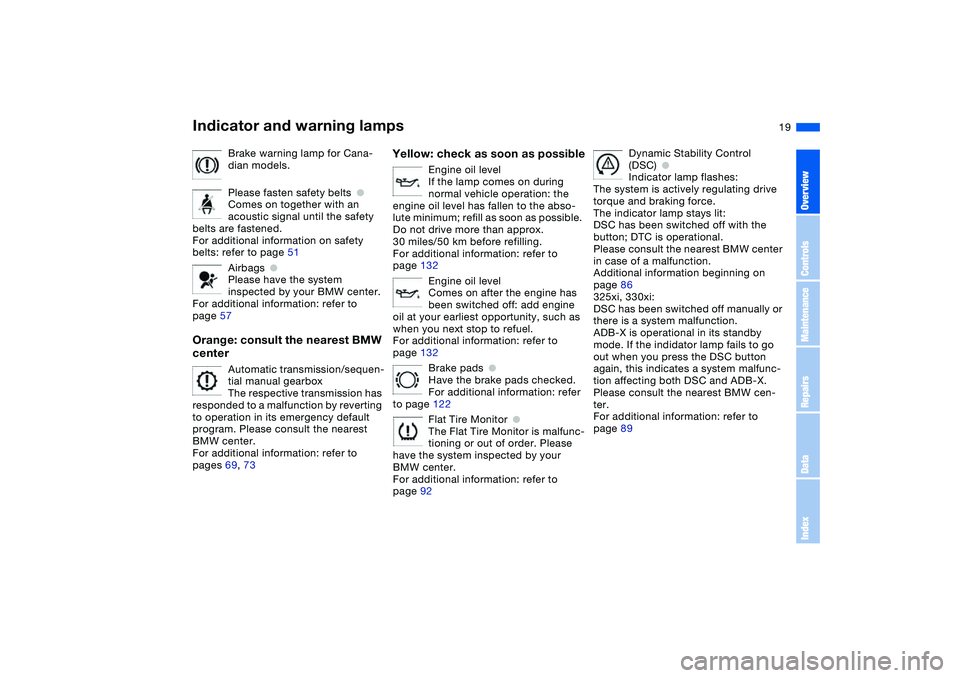
19
Brake warning lamp for Cana-
dian models.
Please fasten safety belts
●
Comes on together with an
acoustic signal until the safety
belts are fastened.
For additional information on safety
belts: refer to page 51
Airbags
●
Please have the system
inspected by your BMW center.
For additional information: refer to
page 57
Orange: consult the nearest BMW
center
Automatic transmission/sequen-
tial manual gearbox
The respective transmission has
responded to a malfunction by reverting
to operation in its emergency default
program. Please consult the nearest
BMW center.
For additional information: refer to
pages 69, 73
Yellow: check as soon as possible
Engine oil level
If the lamp comes on during
normal vehicle operation: the
engine oil level has fallen to the abso-
lute minimum; refill as soon as possible.
Do not drive more than approx.
30 miles/50 km before refilling.
For additional information: refer to
page 132
Engine oil level
Comes on after the engine has
been switched off: add engine
oil at your earliest opportunity, such as
when you next stop to refuel.
For additional information: refer to
page 132
Brake pads
●
Have the brake pads checked.
For additional information: refer
to page 122
Flat Tire Monitor
●
The Flat Tire Monitor is malfunc-
tioning or out of order. Please
have the system inspected by your
BMW center.
For additional information: refer to
page 92
Dynamic Stability Control
(DSC)
●
Indicator lamp flashes:
The system is actively regulating drive
torque and braking force.
The indicator lamp stays lit:
DSC has been switched off with the
button; DTC is operational.
Please consult the nearest BMW center
in case of a malfunction.
Additional information beginning on
page 86
325xi, 330xi:
DSC has been switched off manually or
there is a system malfunction.
ADB-X is operational in its standby
mode. If the indidator lamp fails to go
out when you press the DSC button
again, this indicates a system malfunc-
tion affecting both DSC and ADB-X.
Please consult the nearest BMW cen-
ter.
For additional information: refer to
page 89
Indicator and warning lamps
OverviewControlsMaintenanceRepairsDataIndex
Page 47 of 182
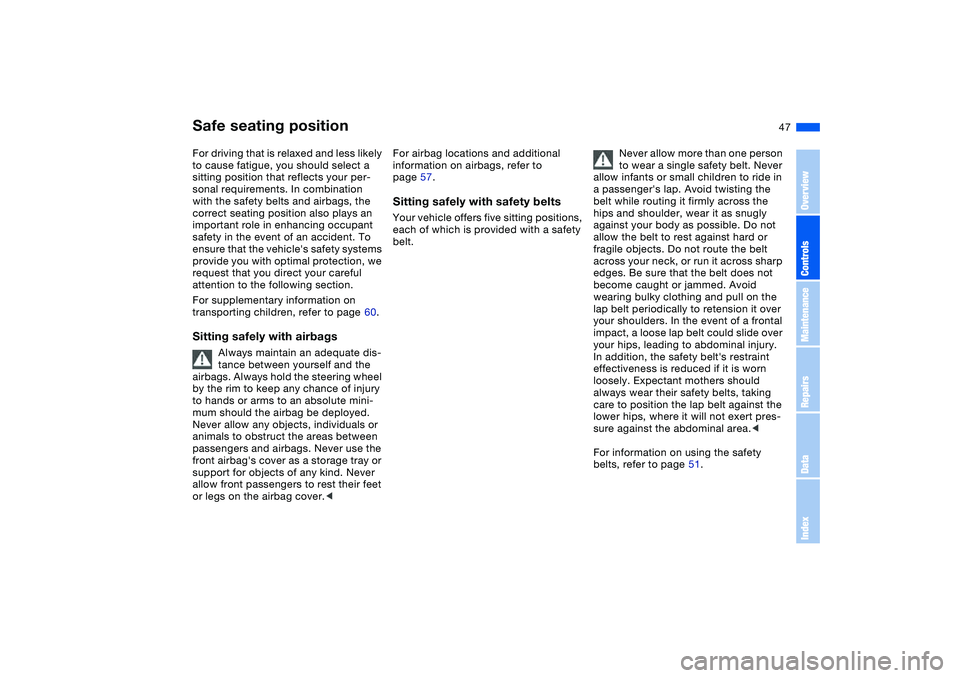
47 To adjust
Safe seating positionFor driving that is relaxed and less likely
to cause fatigue, you should select a
sitting position that reflects your per-
sonal requirements. In combination
with the safety belts and airbags, the
correct seating position also plays an
important role in enhancing occupant
safety in the event of an accident. To
ensure that the vehicle's safety systems
provide you with optimal protection, we
request that you direct your careful
attention to the following section.
For supplementary information on
transporting children, refer to page 60. Sitting safely with airbags
Always maintain an adequate dis-
tance between yourself and the
airbags. Always hold the steering wheel
by the rim to keep any chance of injury
to hands or arms to an absolute mini-
mum should the airbag be deployed.
Never allow any objects, individuals or
animals to obstruct the areas between
passengers and airbags. Never use the
front airbag's cover as a storage tray or
support for objects of any kind. Never
allow front passengers to rest their feet
or legs on the airbag cover.<
For airbag locations and additional
information on airbags, refer to
page 57.Sitting safely with safety beltsYour vehicle offers five sitting positions,
each of which is provided with a safety
belt.Never allow more than one person
to wear a single safety belt. Never
allow infants or small children to ride in
a passenger's lap. Avoid twisting the
belt while routing it firmly across the
hips and shoulder, wear it as snugly
against your body as possible. Do not
allow the belt to rest against hard or
fragile objects. Do not route the belt
across your neck, or run it across sharp
edges. Be sure that the belt does not
become caught or jammed. Avoid
wearing bulky clothing and pull on the
lap belt periodically to retension it over
your shoulders. In the event of a frontal
impact, a loose lap belt could slide over
your hips, leading to abdominal injury.
In addition, the safety belt's restraint
effectiveness is reduced if it is worn
loosely. Expectant mothers should
always wear their safety belts, taking
care to position the lap belt against the
lower hips, where it will not exert pres-
sure against the abdominal area.<
For information on using the safety
belts, refer to page 51.
OverviewControlsMaintenanceRepairsDataIndex
Page 51 of 182
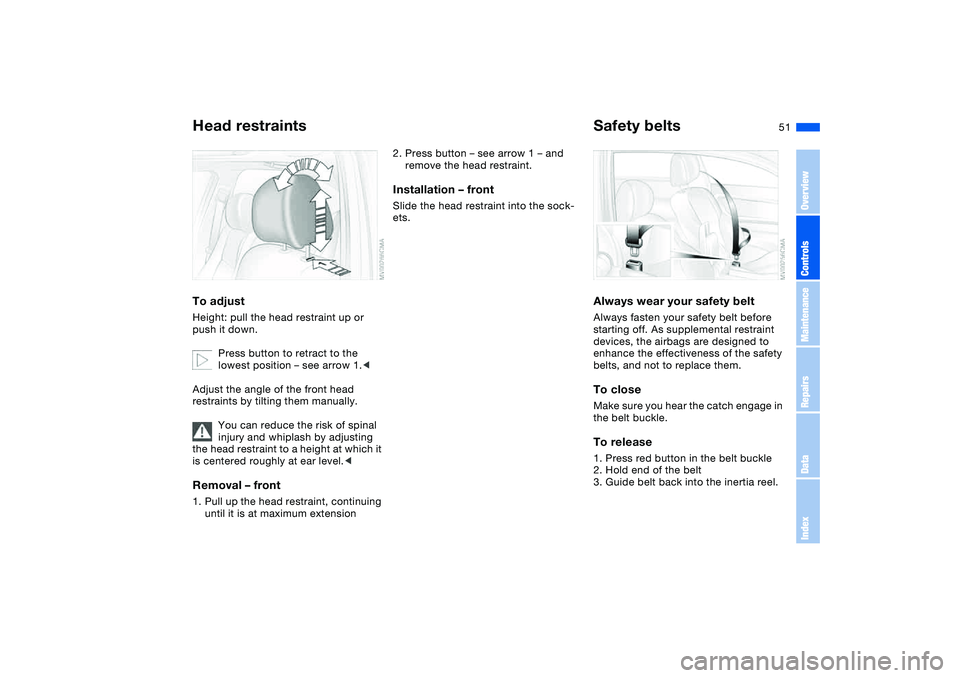
51
Head restraintsTo adjustHeight: pull the head restraint up or
push it down.
Press button to retract to the
lowest position – see arrow 1.<
Adjust the angle of the front head
restraints by tilting them manually.
You can reduce the risk of spinal
injury and whiplash by adjusting
the head restraint to a height at which it
is centered roughly at ear level.
2. Press button – see arrow 1 – and
remove the head restraint.Installation – frontSlide the head restraint into the sock-
ets.
Safety beltsAlways wear your safety beltAlways fasten your safety belt before
starting off. As supplemental restraint
devices, the airbags are designed to
enhance the effectiveness of the safety
belts, and not to replace them.To closeMake sure you hear the catch engage in
the belt buckle.To release1. Press red button in the belt buckle
2. Hold end of the belt
3. Guide belt back into the inertia reel.
OverviewControlsMaintenanceRepairsDataIndex
Page 169 of 182
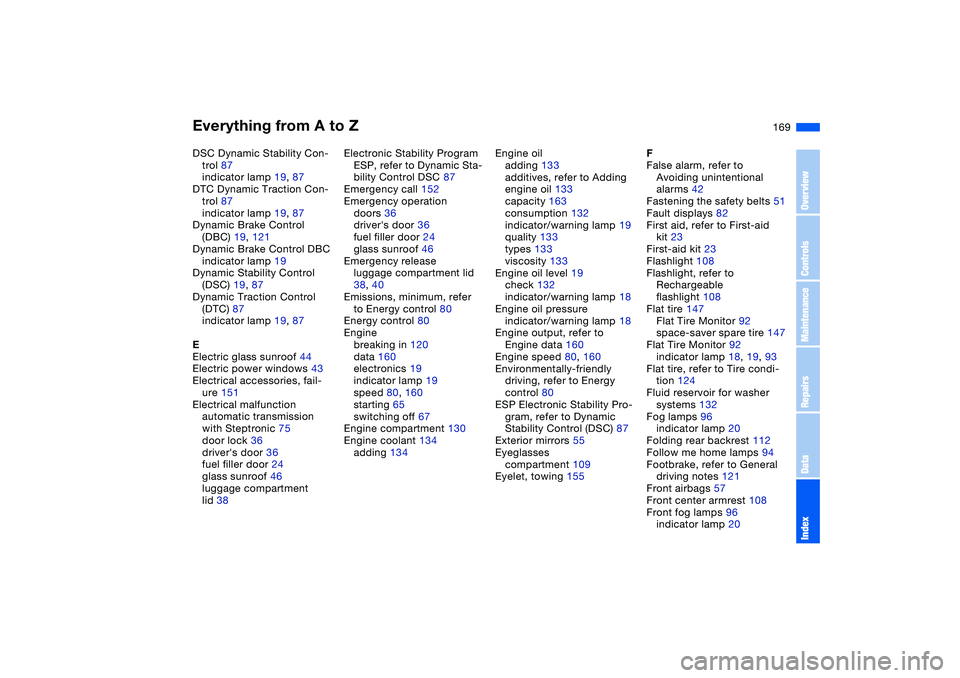
Everything from A to Z
169
DSC Dynamic Stability Con-
trol 87
indicator lamp 19, 87
DTC Dynamic Traction Con-
trol 87
indicator lamp 19, 87
Dynamic Brake Control
(DBC) 19, 121
Dynamic Brake Control DBC
indicator lamp 19
Dynamic Stability Control
(DSC) 19, 87
Dynamic Traction Control
(DTC) 87
indicator lamp 19, 87
E
Electric glass sunroof 44
Electric power windows 43
Electrical accessories, fail-
ure 151
Electrical malfunction
automatic transmission
with Steptronic 75
door lock 36
driver's door 36
fuel filler door 24
glass sunroof 46
luggage compartment
lid 38Electronic Stability Program
ESP, refer to Dynamic Sta-
bility Control DSC 87
Emergency call 152
Emergency operation
doors 36
driver's door 36
fuel filler door 24
glass sunroof 46
Emergency release
luggage compartment lid
38, 40
Emissions, minimum, refer
to Energy control 80
Energy control 80
Engine
breaking in 120
data 160
electronics 19
indicator lamp 19
speed 80, 160
starting 65
switching off 67
Engine compartment 130
Engine coolant 134
adding 134Engine oil
adding 133
additives, refer to Adding
engine oil 133
capacity 163
consumption 132
indicator/warning lamp 19
quality 133
types 133
viscosity 133
Engine oil level 19
check 132
indicator/warning lamp 18
Engine oil pressure
indicator/warning lamp 18
Engine output, refer to
Engine data 160
Engine speed 80, 160
Environmentally-friendly
driving, refer to Energy
control 80
ESP Electronic Stability Pro-
gram, refer to Dynamic
Stability Control (DSC) 87
Exterior mirrors 55
Eyeglasses
compartment 109
Eyelet, towing 155F
False alarm, refer to
Avoiding unintentional
alarms 42
Fastening the safety belts 51
Fault displays 82
First aid, refer to First-aid
kit 23
First-aid kit 23
Flashlight 108
Flashlight, refer to
Rechargeable
flashlight 108
Flat tire 147
Flat Tire Monitor 92
space-saver spare tire 147
Flat Tire Monitor 92
indicator lamp 18, 19, 93
Flat tire, refer to Tire condi-
tion 124
Fluid reservoir for washer
systems 132
Fog lamps 96
indicator lamp 20
Folding rear backrest 112
Follow me home lamps 94
Footbrake, refer to General
driving notes 121
Front airbags 57
Front center armrest 108
Front fog lamps 96
indicator lamp 20
OverviewControlsMaintenanceRepairsDataIndex
Page 171 of 182
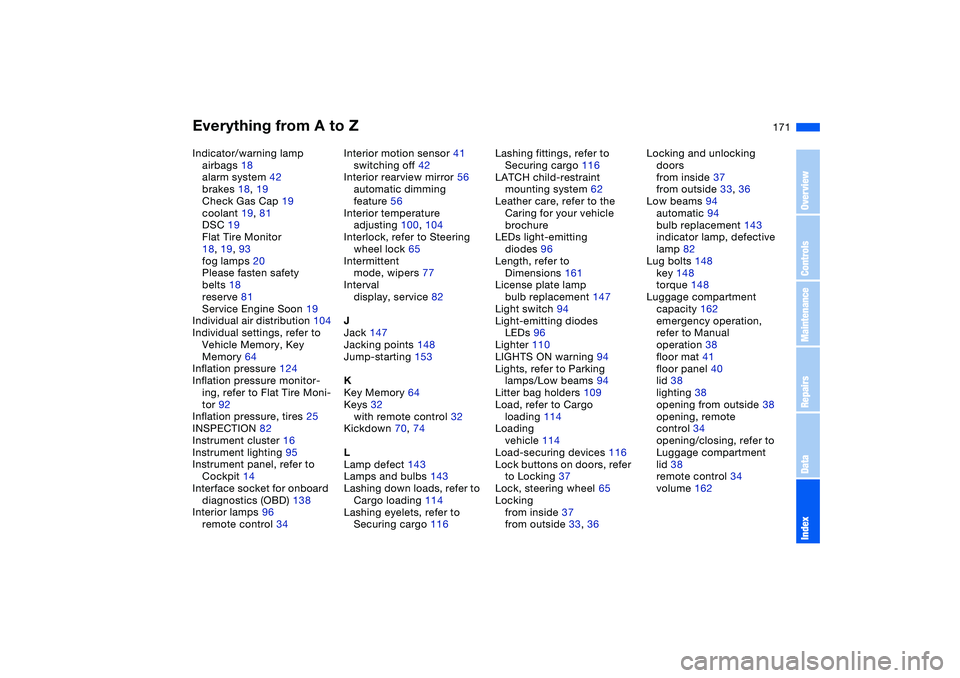
Everything from A to Z
171
Indicator/warning lamp
airbags 18
alarm system 42
brakes 18, 19
Check Gas Cap 19
coolant 19, 81
DSC 19
Flat Tire Monitor
18, 19, 93
fog lamps 20
Please fasten safety
belts 18
reserve 81
Service Engine Soon 19
Individual air distribution 104
Individual settings, refer to
Vehicle Memory, Key
Memory 64
Inflation pressure 124
Inflation pressure monitor-
ing, refer to Flat Tire Moni-
tor 92
Inflation pressure, tires 25
INSPECTION 82
Instrument cluster 16
Instrument lighting 95
Instrument panel, refer to
Cockpit 14
Interface socket for onboard
diagnostics (OBD) 138
Interior lamps 96
remote control 34Interior motion sensor 41
switching off 42
Interior rearview mirror 56
automatic dimming
feature 56
Interior temperature
adjusting 100, 104
Interlock, refer to Steering
wheel lock 65
Intermittent
mode, wipers 77
Interval
display, service 82
J
Jack 147
Jacking points 148
Jump-starting 153
K
Key Memory 64
Keys 32
with remote control 32
Kickdown 70, 74
L
Lamp defect 143
Lamps and bulbs 143
Lashing down loads, refer to
Cargo loading 114
Lashing eyelets, refer to
Securing cargo 116Lashing fittings, refer to
Securing cargo 116
LATCH child-restraint
mounting system 62
Leather care, refer to the
Caring for your vehicle
brochure
LEDs light-emitting
diodes 96
Length, refer to
Dimensions 161
License plate lamp
bulb replacement 147
Light switch 94
Light-emitting diodes
LEDs 96
Lighter 110
LIGHTS ON warning 94
Lights, refer to Parking
lamps/Low beams 94
Litter bag holders 109
Load, refer to Cargo
loading 114
Loading
vehicle 114
Load-securing devices 116
Lock buttons on doors, refer
to Locking 37
Lock, steering wheel 65
Locking
from inside 37
from outside 33, 36Locking and unlocking
doors
from inside 37
from outside 33, 36
Low beams 94
automatic 94
bulb replacement 143
indicator lamp, defective
lamp 82
Lug bolts 148
key 148
torque 148
Luggage compartment
capacity 162
emergency operation,
refer to Manual
operation 38
floor mat 41
floor panel 40
lid 38
lighting 38
opening from outside 38
opening, remote
control 34
opening/closing, refer to
Luggage compartment
lid 38
remote control 34
volume 162
OverviewControlsMaintenanceRepairsDataIndex